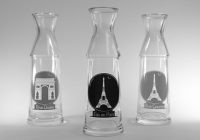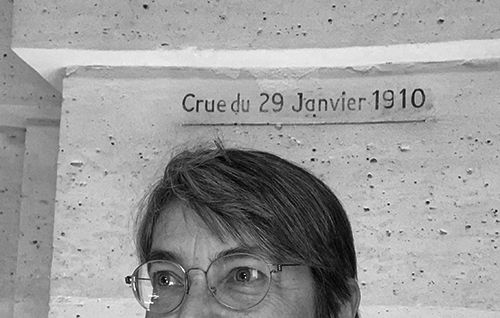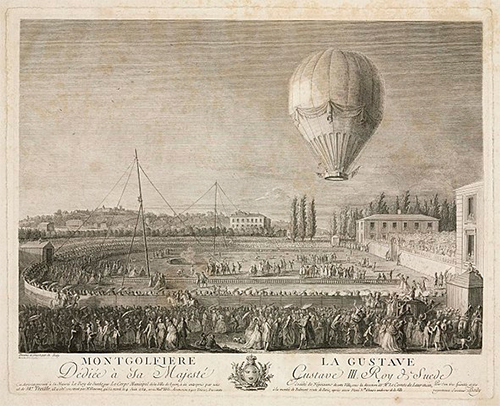Per our May 4, 2019, post, “Paris/France and…” is a new series wherein “and” leads us to categories whose subcategories link to the city/country we know and love. Having explored Paris/France and Body Parts as well as Paris/France and Colors (July 27, 2019), we move on to Paris / France and The Classical Elements (earth, water, air, fire [and ether, which we won’t be discussing here]), starting–floatingly, flowingly, gushingly, splashingly, streamingly–with Paris/France and…
…water: traveling on it, drinking it, splashing around in it, stepping on planks several feet above it *.
TRAVELING ON IT: Do not sell the Seine short. As exquisite as it is, as sublimely as it threads through Paris monuments like a silk cord through necklace gems, it has for millenniums (Is the Neolithic period old enough for you?) been crucially more than background or playground, as you will discover here (read and click on everything you have time for and then some) and here (if your mastery of the language permits, go to Wikipedia’s much longer, more detailed French version of this site).
“But,” the Seine whispers to its surrounding landscape, “we are not alone,” as you’ll find in pages’ worth of sites by plugging “the Bièvre River Paris” into Google, with the same suggestions as above for heavy-duty reading/clicking and favoring the French sites as much as possible. (As you’ll discover, bièvre is an old translation of “beaver,” today called a castor. The tanneries along this river often worked on beaver skins.)

DRINKING IT: If this amusing, informative site does not alleviate fears of drinking from public fountains in Paris, nothing will (click on the colored faucets, and keep scrolllllinnnnnnng dowwwwwnnnnn on the main page)! Nor should we shy away from ordering une carafe d’eau (“tap water”) in a café or restaurant–or merely une carafe once the wine orders have been taken, at which point the waitperson will have figured out to which beverage you are referring, with the more smart-alecky among them, not wanting teetotalers to feel deprived of the grandeur of the grape, referring to city-sourced water as “Château [Whatever president or mayor is in office at the time]”: Château Macron, Château Hidalgo, etc. One thing we should shy away from is the totally non-French practice of asking for ice cubes in our water, although eateries in tourist areas now beat the uninitiated to the punch and provide glaçons without needing to be asked.
SPLASHING AROUND IN IT: Yes, yes, we’re mixing metaphors here. Gene Kelly sang in the rain in the Los Angeles-based plot of Singin’ in the Rain, as opposed to dancing in la place publique in the Paris-based plot of An American in Paris. (Kelly is said to have had a fever when filming the rain scene, which makes his brilliance even more breathtaking!) But that powerful precipitation could just as believably have been falling on the City of Light as on the City of Angels. It sometimes seems as if there are only four non-rainy, non-barbarously windy, non-death-defyingly frigorified, non-massive-mold-build-up-in-closets-due-to-industrial-strength-humidity (usually all at the same time) days during any given year in Paris (and some of the rest of France)–one each in July, August, September and October–and as if every songwriter from the 12th-century troubadours to Cole Porter who ever included any of the following words in their compositions about the region must have had the good fortune to rove or land on one of those four days: clear skies, sun, warm breeze.
In reality, the experts put the average level of Paris precipitation at about a third of the year, thanks to data available via the science of pluviometry–pluviométrie in French, in which we can see the words la pluie (the feminine noun meaning “rain,” from the Latin feminine pluvia) and pleuvoir (“to rain,” from the Latin pluere), not to be confused with the French pleurer, which = to cry, which = rain-from-the-eyes.
Due to its tendency to be rainy, Pluviôse was the fifth month in the French Republican (Revolutionary) Calendar, which gave the months new names based mainly on meteorological and agricultural phenomena. As the calendar year started on the 22nd, 23rd, or 24th of what the Gregorian Calendar calls September, this fifth month ran from the 20th, 21st, or 22nd of (the Gregorian) January to the 19th, 20th, or 21st of (the Gregorian) February.

STEPPING ON PLANKS SEVERAL FEET ABOVE IT, as some of these folks are doing during the 1910 Great Flood of Paris, considered the worst such occurrence since 1658, peaking on January 28 after ten days of rising water and not subsiding until 35 days later! It is heart-stopping to visit some of the affected neighborhoods and compare their dry state to that captured by the era’s increasingly more sophisticated cameras.
Paris is peppered with plaques designating the height of the Seine during those dire days 109 years ago (and some concerning earlier inundations), often stopping unsuspecting strollers in their tracks and making for inspired scavenger-hunting. Not surprisingly, the plaque noting the maximum water level–around shoulder-high for an average person–is not too far from Notre Dame, which is right at the Seine itself (if you wander into the knot of narrow streets and alleys between the cathedral and the river, you will likely find it). The word crue on these markers, meaning “rise in water level” or “flood,” is usually used along with the word or name for that which has flooded: crue de la Seine, for example. The similar-to-English inondation is the more general word for “flood,” and whereas one would not usually say une crue d’idées, as ideas are not a body of water, one could say une inondation d’idées. The way the French explain this is that crue describes the water’s act of rising, whereas inondation is the result of that act–once, for instance, the banks of a river have been overflowed. And crue should not be confused with cru, which as an adjective means “raw” (as a feminine adjective it is spelled crue) and as a noun means “vintage” (and some other wine-related phenomena).

This disaster is referred to as “the centennial flood,” as there have been major Paris floods during almost every recent century. It is feared that the city is overdue for the next one, as highlighted in this article and the striking video entitled “Paris Under Water” on the left side a bit down its page. Plugging “Paris flood of the century” into Google gets you to a considerable number of similar sites. As some of them state, ever since the last one, the city and its residents have been preparing for the next one: moving archives to suburban warehouses; reinforcing underground walls; accompanying property sales with elaborate, color-coded “flood zone” paperwork alerting buyers as to general risks, geographically determined levels of risk and related phenomena.
And of course, rains lasting for more than several days in a row are inevitably punctuated by cries of “HERE IT COMES! THE CENTENNIAL FLOOD IS UPON US!”
* Be sure to check out fusac.fr’s feature on Paris and water:
- La Seine
- Drinking water
- Non-Drinking water
- Crossing the Seine
- Canals
- Watery Tidbits
- Speak Easy, idomatic expressions using water
- 2016 flood
air: breathing it, flying in it, looking at its artwork, smelling it
BREATHING IT: You are an outdoor biker, runner, swimmer, or rower. You leave your Paris apartment for a weekend and go visit a pal in the remote countryside. While there, you work out as usual. But this time you seem to effortlessly bike, run, swim, row farther and faster than you ever did in the city. “Wow!” you declare to your friend as you skip jauntily to the shower, “I must REALLY have IMPROVED OVERNIGHT! Must be that organic ginseng I’ve been putting in my soup!” Nope. Must be the lack of Paris pollution that pitilessly pummels your poumons (“lungs”).
Speaking of which, here (the glaring instance of “franglais” in the second sentence notwithstanding) is where you can get the lowdown on where what microparticles are massing, especially if you click on everything that’s clickable on in both the English and the French sites, the latter accessible by clicking on “here” in the English site’s intro. The graphics in both sites’ documents range from excellent to absolutely dazzling, all in the service of these sometimes frightening, always enlightening reports, press releases, summaries and other items.
Airparif reports are also often scattered around town on the electronic Paris-info boards that, in addition, can provide time, temperature, news, event listings and messages such as “Heatwave warning: Drink water!”

FLYING IN IT: When after watching the first manned Montgolfier balloon take off in Paris on November 21, 1783, Benjamin Franklin was asked what use such a contraption could have, he famously answered, “What is the use of a newborn child?” However, the Enlightenment-era scientist in him did not stop at that quip, per this textual and audio exploration of his balloon-related musings and correspondence.
But neither the Montgolfier nor even the French presidential plane are the airborne entities most associated with Paris and some of the rest of France. That honor goes to those that at this very moment might be landing in great groupings before your front door, under your window, in your courtyard, around your trashcans, on your roof, at your feet, seemingly insouciantly unaware of your presence and maliciously determined to irk you at the same time. Oh, come on–you know who we mean!
* LOOKING AT ITS ARTWORK: This is why it’s great to gaze at clouds, the air’s artwork! Here is where you can lie on your back and watch them morph into the most fabulous of forms!
* SMELLING IT: Paris used to smell like cigarettes), diesel fuel and food. Then came the smoking ban, following which Paris smelled like diesel fuel and food. After the diesel-fuel ban, Paris will smell like food. (Paris will always smell like food.)
And unless there is a great change in someone’s idea of an interesting exhibition, the area around the south (Left Bank) end of the Pont de l’Alma (the Alma Bridge) will always smell a bit like sewage; it can’t help itself.
earth–as in sod, soil, land, terrain, turf.
As in the good stuff beneath your feet. And no discussion of Paris (more precisely, of France) and earth would be valid without exploring the concept of terroir. Terroir. Terroir is a near-sacred concept, because the French are attached to the land to an almost religious extent. In addition to, according to linguee.fr, “the set of special [tangible] characteristics that the geography, geology and climate of a certain place, interacting with plant genetics, express in agricultural products such as wine, coffee, chocolate, hops, tomatoes, heritage wheat, and tea,” terroir is understood in an intangible cultural sense that is nigh onto impossible for a non-French native to totally grasp–although reading the entirety of this relatively short explanation might help.

While this page provides the quite good translation “a sense of place,” it also informs us that the term is otherwise so untranslatable that for English texts either the French word is maintained or conveying the meaning “requires the use of complete sentences.” Toward the bottom of the page, among the many aids to understanding this concept, you will find that “there is no French synonym for [terroir] in a single word either”!
The French define themselves in terms of the land to such an extent that unless they were born and raised in Paris, sometimes when they say “my country” they mean not the nation of France but the part of it “where I was born and grew up and where my perfect mother cooked perfect meals for our perfect family under perfect skies while we spoke about the perfect state of the cosmos”–a Gallic version of “hometown.” This could be the entirety of Corsica (which is part of France) or a little patch of Normand farmland and anything in between. Mon pays (“my country”) is always uttered with nostalgia in the voice and reverence in the eyes. And a subsequent pause……to let all that long-lost flawlessness wash back in. This can be stunningly confusing to the uninitiated: “Where are you going for Christmas?” – “To my country.” – “Oh! I thought you were French.” – “I am French.” – “Well, you’re already in your country.” – “No I’m not. I’m in Paris.”
fire:
Some (among other) expressions (often logically) using feu (“fire”) in French but not English:
- feu vert/feu rouge = green (traffic) light/red (traffic) light…To have your boss’s feu vert thus = to have your boss’s “go-ahead,” i.e., your boss is “green-lighting” your project.
- Avez-vous du feu? = Do you have a light (for my cigarette)?
- feu mon père / feue ma mère / etc. = my late (“deceased”) father/mother/etc.
- les arts du feu = ceramics (i.e., artwork created via the use of fire)
- Il n’y a pas le feu. = There’s no rush; take your time (“Where’s the fire?”)
Some (among other) expressions using “fire” in English but not in French:
- He was fired (from his job) = Il a été licencié / Il a été renvoyé (“sent away”: envoyer = “to send”) / Il a été viré (“sacked,” thus, an informal expression–among several other meanings of the verb virer) / Il a été mis à la porte (“shown the door” [literally: “put at the door”]; the feminine version is Elle a été mise à la porte).
- fireman = pompier (They pump water, don’t they?) They are sometimes also called sapeurs-pompiers (with “sap” in this sense possibly referring to draining water from a given source for fighting the fire) and soldats du feu, which = “fire soldiers,” especially since in Paris and Marseille they are part of the military. Why only Paris and Marseille? Maybe after this entire “Paris/France and…” series is finished we can share fascinating facts and figures about the French military in general and answer this question in particular.
- a firebrand = agitateur-agitatrice (feminine) / perturbateur-perturbatrice / trublion (“troublemaker”) / plus some vulgarisms
See you soon for the next instalment in our “Paris/France and…” series!
Shari Leslie Segall is a writer who lives amongst the Paris elements.


